Revitalizing Veteran’s Park: A Blueprint for Tomorrow
Norwalk is on the brink of a transformative project that will reimagine Veteran's Memorial Park (Vet’s Park) into a beacon of resilience, environmental stewardship, and community engagement. The City of Norwalk with the help of the National Fish and Wildlife Foundation, are commencing a redesign project for Vet’s Park. This ambitious project aims to harness the power of green infrastructure, nature-based solutions, and living shorelines to not only combat climate change impacts but also to elevate the quality of life for its residents.
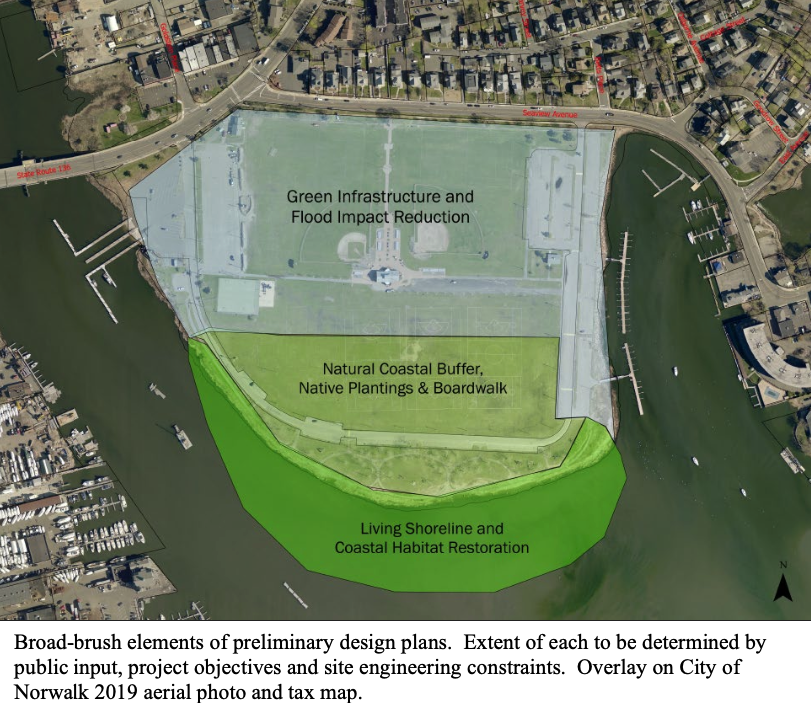
Project Vision
At the heart of this redesign is the commitment to prepare Vet’s Park for the challenges of stormwater management, flooding, and erosion while enhancing its 36-acre waterfront expanse. By integrating flood-adaptive public spaces, the initiative seeks to guide future implementation plans that will bolster coastal habitat, improve public shoreline access, and increase the park's resilience to environmental adversities.
The Challenge & Solution
Once a thriving tidal wetland, Vet's Park has faced decades of ecological neglect, manifested in erosion, flooding, and diminished habitat value. Today, the park is plagued with:
- Chronic erosion
- Lack of stormwater management
- Recurring coastal flooding
- Saltwater inundation
The City’s solution revolves around a comprehensive site assessment and the creation of conceptual design plans. These plans envision a park that is not only a recreational haven but also a front-line defender against sea level rise, offering a restored coastal marsh, native plant habitats, and innovative stormwater management techniques.
The conceptual plans include the installation of green infrastructure around the northern portions of the park to protect it from flooding impacts, reduce the volume of stormwater runoff, and improve the quality of the runoff water through capture and filtration systems.
The southern portions of the park would be reverted back into a protective native plant habitat. A “buffer” design would provide room for sea level rise migration of the coastal marsh, give rise to migratory and native bird habitats, and be partially accessible with a boardwalk.
Community & Ecological Impact
The redesign of Vet's Park is poised to redefine its role within the community and the broader ecosystem of Norwalk Harbor. By transitioning areas of the park into native plant-dominated habitats and installing living shorelines, the project will enhance:
- Biodiversity
- Improve water quality
- Provide essential habitats for local wildlife
Furthermore, the initiative will reintroduce the park as a vibrant community asset, where recreation, accessibility, and ecological responsibility intersect.
Engagement & Education
In partnership with The Maritime Aquarium and the City’s Recreation & Parks Department, the redesigned park will serve as an educational platform, connecting urban residents with the natural splendors of Long Island Sound. Through hands-on programming and stewardship opportunities, the project aims to foster a sense of community ownership and environmental awareness among Norwalk's residents.
Looking Forward
As we embark on this journey to revitalize Veteran's Memorial Park, we are guided by a vision of sustainability, resilience, and community enrichment. The project not only aims to restore the park's ecological integrity but also to create a space where nature and community thrive in harmony. We invite the residents of Norwalk to join us in shaping the future of Veteran's Park, a future where the legacy of our veterans is honored through our commitment to preserving and enhancing our natural heritage for generations to come.
Stay tuned to Norwalk Tomorrow for updates on this exciting project, as we work together to make Veteran's Park a model of urban resilience and environmental stewardship. Click here to subscribe to our email list and receive the latest news and announcements. Public Arts and the Role It Plays in Economic Development
As cities continue to grow and evolve, the role of art in public places becomes increasingly important. Not only does it add beauty and character to urban spaces, but it also has a significant impact on economic development. Here in Norwalk, CT, we have seen firsthand how commissioning public art can benefit our city and its residents. Our community's identity has been strengthened by groups like the Norwalk Arts and Cultural Commission and the Norwalk Historical Society that support the city in creating colorful murals, traffic graphics, and interactive sculptures in Norwalk, CT.
The Benefits of Public Art
Commissioning public art can bring numerous benefits to a city, including:
- Attracting tourists and visitors: Public art has the power to draw people in and make them want to explore a city. This can result in increased tourism and economic growth.
- Enhancing public spaces: By adding art to public spaces, we can make them more engaging and enjoyable for residents and visitors. This can also lead to a sense of pride and ownership among the community.
- Encouraging dialogue and interaction: Public art often sparks conversations and allows people to connect in unique ways. It can serve as a catalyst for meaningful discussions about relevant social issues.
- Supporting local artists: Commissioning public art provides a platform for local artists to showcase their talents and contribute to the community's cultural landscape.
Norwalk's Art Commission
 The Norwalk Arts and Cultural Commission is an essential part of our city's public art initiatives. They understand the significant impact of art on economic growth and play a crucial role in enhancing Norwalk's cultural scene. The commission is at the forefront of our public art efforts and is instrumental in enriching Norwalk's cultural landscape.
Composed of 11 Norwalk residents appointed by the Mayor and Common Council, the commission brings together artists, architects, educators, and passionate community members. This rich tapestry of perspectives helps to ensure that each piece of art commissioned embodies our community's shared values and aspirations.
The core function of the commission is not just to select and oversee the installation of artwork, but also to ensure that each commissioned piece speaks to the heart of Norwalk. Through their work, the commission aims to inspire creativity, foster community dialogue, and enhance the visual appeal of our city. Monthly commission meetings are held on the 1st Tuesday of every month at 6:00 PM and are open to everyone.
Their efforts have contributed to the vibrant public art scene in Norwalk, transforming our city into an open-air gallery that beckons visitors and instills pride in residents. This is a testament to the power of art in driving economic development and enhancing the quality of life in our city.
The Norwalk Arts and Cultural Commission is an essential part of our city's public art initiatives. They understand the significant impact of art on economic growth and play a crucial role in enhancing Norwalk's cultural scene. The commission is at the forefront of our public art efforts and is instrumental in enriching Norwalk's cultural landscape.
Composed of 11 Norwalk residents appointed by the Mayor and Common Council, the commission brings together artists, architects, educators, and passionate community members. This rich tapestry of perspectives helps to ensure that each piece of art commissioned embodies our community's shared values and aspirations.
The core function of the commission is not just to select and oversee the installation of artwork, but also to ensure that each commissioned piece speaks to the heart of Norwalk. Through their work, the commission aims to inspire creativity, foster community dialogue, and enhance the visual appeal of our city. Monthly commission meetings are held on the 1st Tuesday of every month at 6:00 PM and are open to everyone.
Their efforts have contributed to the vibrant public art scene in Norwalk, transforming our city into an open-air gallery that beckons visitors and instills pride in residents. This is a testament to the power of art in driving economic development and enhancing the quality of life in our city.
Norwalk, CT Public Art
One of the remarkable aspects of Norwalk's public art initiative is the diverse backgrounds of the artists it features. Our city's public art scene is a canvas where the local and international confluence happens, resulting in a vibrant cultural mosaic.
 Many local talents like Duvian Montoya, David Boyajian, and Raf Santaella (aka @5ivefingaz) have contributed immensely to the city's public art landscape. Montoya's mural, "Circus Coming to Town," humorously and nostalgically captures the city's historic link to the Ringling Brothers’ circus, while Boyajian's "Pinwheel," an elegant, twisting metal sculpture, adds a touch of abstract beauty to Mathews Park.
Many local talents like Duvian Montoya, David Boyajian, and Raf Santaella (aka @5ivefingaz) have contributed immensely to the city's public art landscape. Montoya's mural, "Circus Coming to Town," humorously and nostalgically captures the city's historic link to the Ringling Brothers’ circus, while Boyajian's "Pinwheel," an elegant, twisting metal sculpture, adds a touch of abstract beauty to Mathews Park.
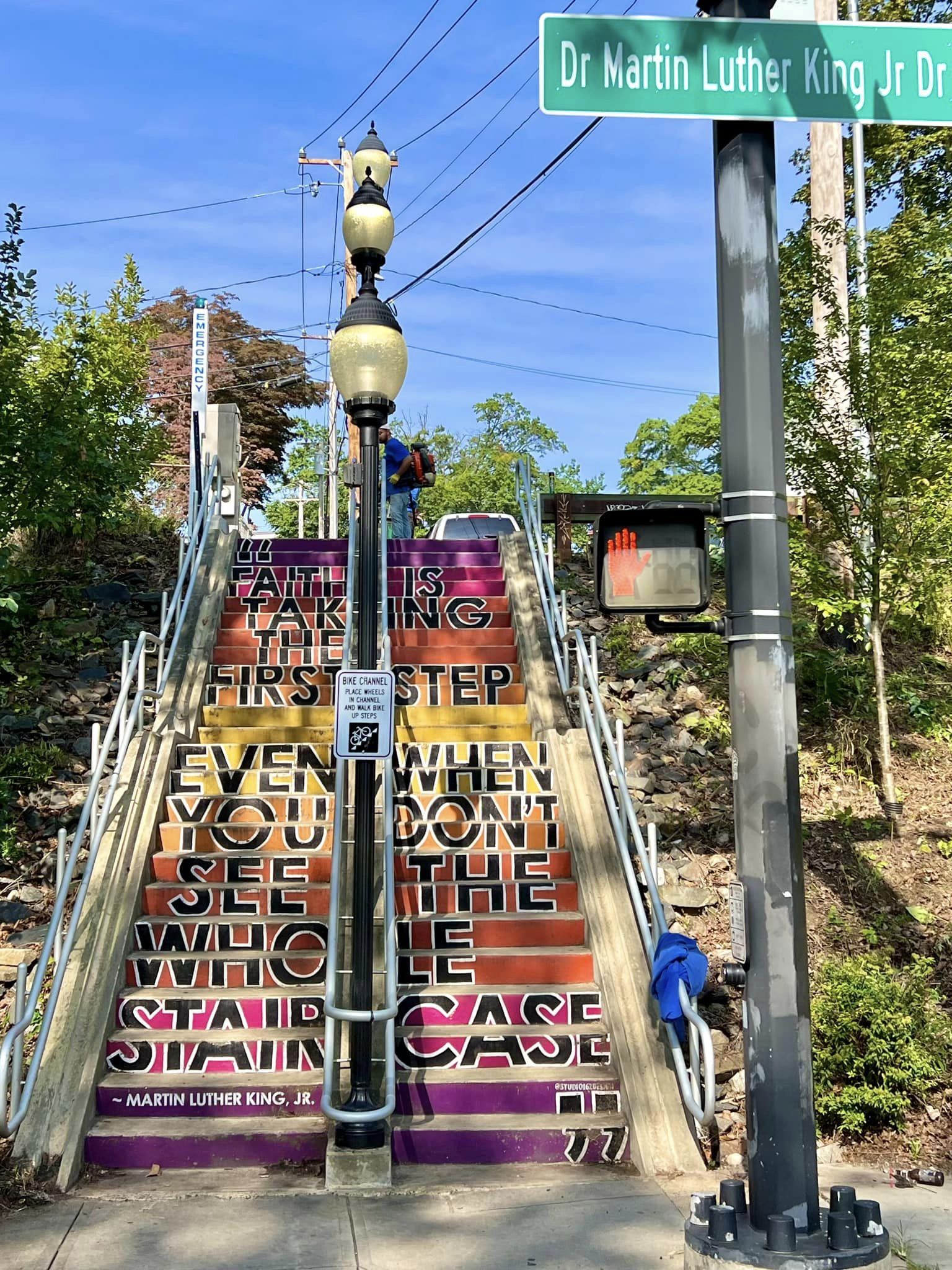 Norwalk's art scene has also been enriched by artists with distinct voices. One such example is "The Promised Land,” painted by Lauren Clayton, a Stamford-based artist with Norwalk roots.. Her murals, located in two locations - the pump station at the intersection of Wilson and MLK Avenues, and the renovated staircase leading down from the South Norwalk train station - were created to honor MLK’s legacy and build a sense of community.
This mixture of diverse artistic expressions from local and international artists strengthens Norwalk's cultural scene while contributing to its economic growth. Public spaces for art make our city more engaging and enjoyable for residents and visitors, leading to a sense of pride and ownership in the community.
Norwalk's art scene has also been enriched by artists with distinct voices. One such example is "The Promised Land,” painted by Lauren Clayton, a Stamford-based artist with Norwalk roots.. Her murals, located in two locations - the pump station at the intersection of Wilson and MLK Avenues, and the renovated staircase leading down from the South Norwalk train station - were created to honor MLK’s legacy and build a sense of community.
This mixture of diverse artistic expressions from local and international artists strengthens Norwalk's cultural scene while contributing to its economic growth. Public spaces for art make our city more engaging and enjoyable for residents and visitors, leading to a sense of pride and ownership in the community.
Join Us in Shaping Norwalk's Future
Public art has the power to captivate people and make them want to explore the city. Art enhances public spaces by making them more engaging and creating a sense of pride and ownership in the community. Commissioning public art provides a platform for local artists to showcase their talents and contribute to the cultural landscape of the community.
We invite you to join Norwalk, Connecticut public art initiatives. There are so many ways you can get involved - attend meetings and events, share your thoughts on social media, or even submit your ideas for future projects. Let's work together to make Norwalk an even more welcoming and vibrant place! #SupportNorwalkArts
You may follow Norwalk arts initiatives on on Facebook and Instagram for more updates, or email sgodeski@norwalkct.gov with any questions you may have. Affordable Housing Plan
City Planning Efforts
Norwalk is working on an Affordable Housing Action Plan to assess the City’s affordable housing needs and address their potential economic, environmental, and social equity impacts. The State of Connecticut defines "affordable rental and homeownership units” as housing that costs no more than 30% of a household’s income.
The Affordable Housing Action Plan will help the City to identify the different levels and types of affordable housing needed while providing guidance and direction on how to achieve that. The intent of the Plan is also to meet the
State mandated 8-30j regulation and any updates to the regulation that are made during the planning process. There is currently a State Commission reviewing the requirements of the state-mandated affordable housing plan, so we expect there will be changes to this RFP.
Plan Goals
- An inventory of the City’s existing housing and its current conditions
- An analysis of housing needs, cost, and affordability
- Trends in housing costs and housing development
- A projection of housing needs for the medium - (next 5 years) and long-term (10 years).
- A comparison between housing trends and housing needs
- An analysis of the City’s housing programs and tools, including a gap analysis, their effectiveness in meeting goals, how well they are targeted towards housing needs, and how they can be improved
- A desirable development scenario with input from the city, the public, and other stakeholders
- Strategies to safeguard housing affordability and increase economic opportunity for current and future residents
- Comprehensive implementation strategy and timeline, based on the affordable housing scenarios
- Guidebook to affordable housing in Norwalk for residents and government officials
Other Resources
Plan Materials
Norwalk's New Business Development Center
Norwalk is recognized by families and businesses as one of the best places to live. Its population now exceeds 92,000 residents and it is the 6th largest city in Connecticut. It comes as no surprise that there is a lot of economic opportunity in Norwalk, and new businesses are starting up on a very regular basis. To aid Norwalk-based entrepreneurs and new business owners, the city has created a new Business Development Center. Read on to learn about this brand new facility and the services provided.
What is the Business Development Center?
[caption id="attachment_2140" align="alignleft" width="1024"]
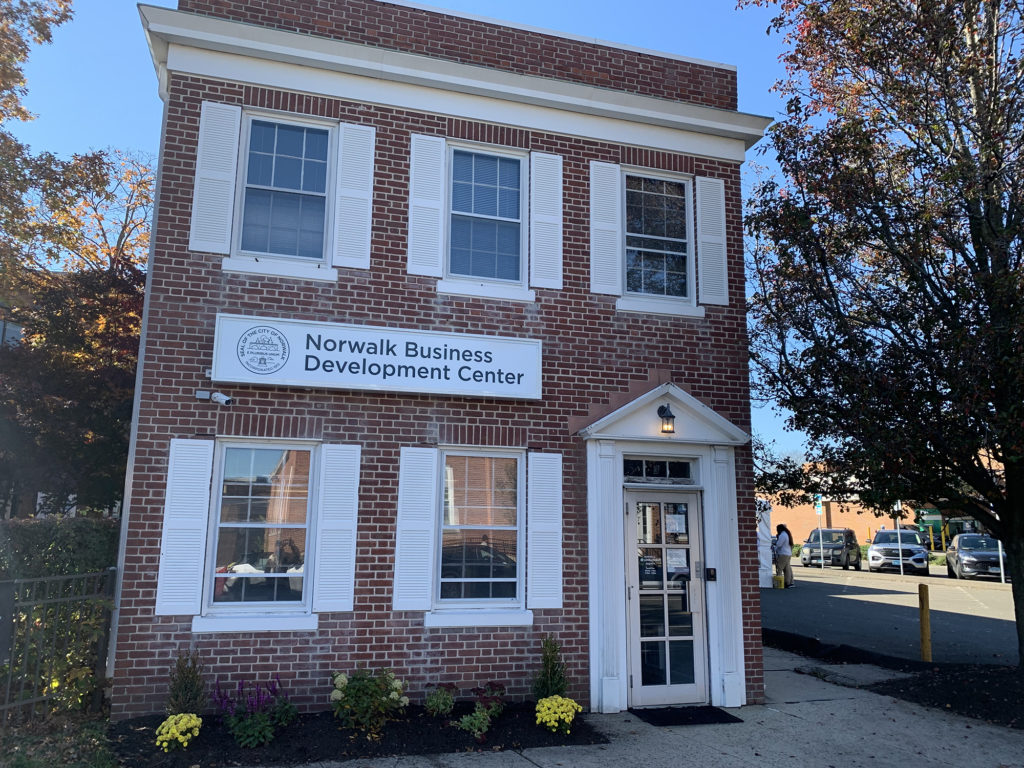
Photo courtesy of Nancy Chapman[/caption]
The new business center, located at 3 Belden Avenue, was opened on November 3, 2022. It’s designed to be an all-inclusive resource that entrepreneurs and business owners can utilize throughout the life cycle of their businesses. This center was constructed using various sources of federal, state, and local funding. The American Rescue Plan Act gave the development center a vital infusion of funding to help complete it.
"We have the opportunity to have staff onsite to be able to assist with local and state grants, be able to build business plans, business models, offer professional development training, and be able to offer residents…and people in the region, as a whole, an opportunity to be able to take a dream that they may have stored for a very long time and actually make it a reality,” says Jessica Vonashek, Chief of Economic and Community Development for the City of Norwalk.
What Services does the Business Development Center Provide?
 Whether you are looking at starting a business or expanding one, the development center can help you. Services are extensive and cover a variety of topics:
Whether you are looking at starting a business or expanding one, the development center can help you. Services are extensive and cover a variety of topics:
- Financial Education
- Loan or Grant Application Assistance
- Technical Support for Local, State, or Federal Permitting
- Business Plan Development and Implementation
- Local and State Licensing Requirements
- Insurance for Your Business
- Market Research
Financing is another popular topic among entrepreneurs. Prospective business owners want to know how to infuse capital into their companies. The Business Development Center resources can walk you through traditional lending options, local programs, and Small Business Administration (SBA) programs.
All of these resources are available free of charge to ensure these resources are accessible to everyone.
The Business Development Center is a partnership with the City of Norwalk, the Greater Norwalk Hispanic Chamber of Commerce, The Greater Norwalk Chamber of Commerce, SCORE, the Small Business Development Council, the Norwalk Redevelopment Agency, the Women’s Business Development Council, and the NAACP. This partnership ensures that there is support for your business that is diverse and equitable.
Have More Questions?
With the help of private sector experts and higher-education resources, you can make your dream of starting your new business in Norwalk, CT a reality. If you want to learn more about Norwalk’s Business Development Center, contact us today or come visit us at the Norwalk Business Development Center Monday through Friday from 9 am to 4 pm. Recommendations for Norwalk's Industrial Waterfront
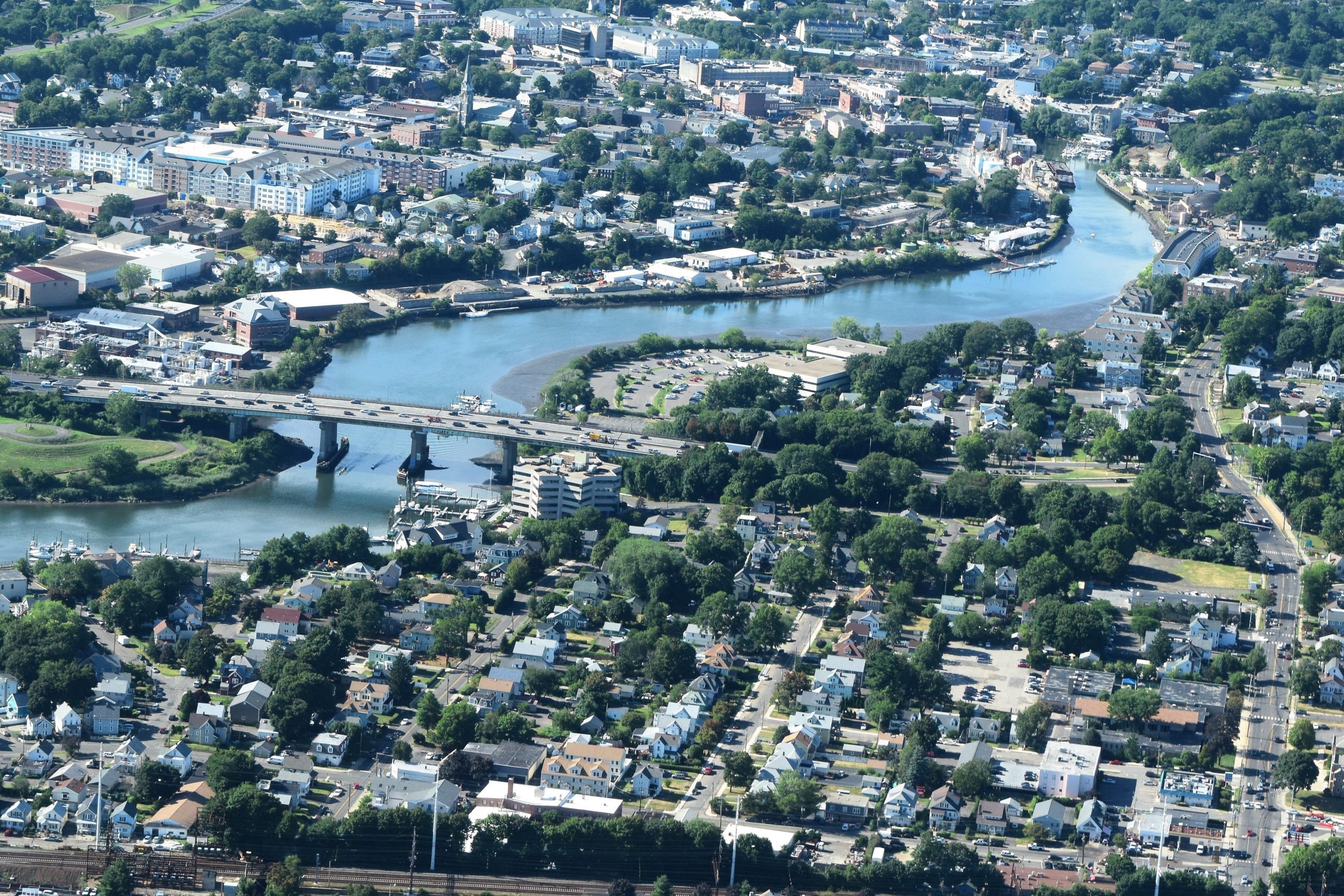 A significant portion of the waterfront in Norwalk, CT has been zoned and used for industrial use. The city undertook a planning exercise to determine the appropriate land uses for these historically industrial waterfronts. The draft plan, Industrial Waterfront Land Use Plan, has been developed for the city to use as a policy roadmap, allowing these areas to grow and change in a way that balances and aligns with both public and private needs.
A significant portion of the waterfront in Norwalk, CT has been zoned and used for industrial use. The city undertook a planning exercise to determine the appropriate land uses for these historically industrial waterfronts. The draft plan, Industrial Waterfront Land Use Plan, has been developed for the city to use as a policy roadmap, allowing these areas to grow and change in a way that balances and aligns with both public and private needs.
Changes to the zoning laws around the Norwalk waterfront will be aimed at promoting economic development and preserving the water dependent uses in the area, while also increasing public access, improving water quality through improved drainage techniques and providing native vegetative buffers, while also improving the built environment.
Read more to find out some of these suggestions for how to revise this waterfront.
Why the Norwalk, CT Waterfront Rezoning Matters
Before we begin, let’s take a quick look at why the Norwalk waterfront needed to be reevaluated.
It’s quite an understatement to say that industrial waterfront land has vastly changed in the last century. In Norwalk, the use of industrial waterfront has been transitioning from strictly industrial uses to less intense uses, such as marinas and small boat facilities, while legacy uses such as oyster harvesting and bulkhead repairs continue to be integral parts of the community. In addition, modern innovations, like the innovative boat building and storage or marine highway programs like harbor harvest hold promise for future economic success for our harbor.
However, updating industrial waterfronts comes with its challenges. The historical use of Norwalk's urban waterfront plays such an enormous part in the city's identity. It's also an essential piece of the local economy.
The Norwalk waterfront has an array of uses.Some areas are zoned exclusively for heavy industrial uses, while others are reserved for commercial or public use and some have a mix of uses which can include residential
This is why the Norwalk Industrial Waterfront Land Use planning process looked at ways to benefit both public and private institutions alike, including the input of many stakeholders to thoughtfully address these uses. Read further to learn about the major themes that occurred throughout the planning process.
1. Increased Public Access
One common desire mentioned in the numerous meetings with the public is for Norwalk residents and tourists to have more access to the waterfront. An asphalt factory near the head of the Norwalk river is a good example. Not only is The facility under-utilized, but locating an asphalt plant in proximity to your downtown is not a desired land-use scenario. In addition, the public feels the land could better serve the community by broadening its usage.
This automatically indicates the need for changing the zoning laws, which is already underway. This site would need to be rezoned from its current industrial status. It's just one example of how shifting the zoning laws may impact the broader waterfront ecology.
2. Reduced Heavy Industry
Rezoning to determine the appropriate types of heavy industrial usage and where they should be located have been common themes across every public meeting. The current zoning laws prioritize heavy industry. The updated zoning regulations would increase light industrial and artisanal industries.
These would be able to exist alongside residential zones to buffer more heavy industrial uses. This would allow for more mixed-use areas near the waterfront.
3. Mixed Use
Whatever form the final rezoning takes, mixed-use could play an important part. We see this in the proposal of placing light industry next to residential, for instance.
This would open the way for mixed-use marine commercial zoning, allowing more marine commercial businesses to remain on the waterfront while opening up the area around them for mixed uses. Examples of marine commercial businesses could include yacht clubs or marinas while mixed uses could be a marine retail store with residential above.
4. Reimagining Water Street
How Water Street looks, feels and functions has been debated many times over the years. The Plan’s vision for the area strives to strike a balance between the desire for public access and views of the water, with the need to support Norwalk’s thriving marine industries, while also improving the built environment of the street to compliment the desired development occurring elsewhere in the neighborhood.
Increasing the amount of greenery, particularly waterfront buffers, is another common concern, which would also help to address environmental issues. This is another major goal for many of the proposed changes to the industrial waterfront.
These suggestions will all help to keep the area vital, making it more appealing to residents and visitors.
5. Retain Protect, and Reinvest in Water-Dependent Businesses
There was consensus among stakeholders of the need to support and maybe even expand businesses that are water dependent in Norwalk, especially in the Water Street Marina area in South Norwalk. The concern is that they continue to contribute to Norwalk and the regional economy.
Ways to do this include: increasing the protected marine commercial zone and investing in infrastructure for these industries– such as bulkheads, dock repairs, and dredging of the Norwalk River.
While this is an acknowledged goal of the plan, it must be done in a way that considers the other identified needs and goals of the study, so the waterfront is resilient, active and accessible to all.
6. Preserve the Environment and Prepare for Resiliency
For waterfront areas, consideration of environmental factors is especially important. Recommendations for all the waterfront parcels is to increase flood resilience, improve water quality, and promote ecological restoration.
Investing in things like impermeable to permeable pavement or vegetation/soft shoreline would help reduce flooding in the more urban areas of the waterfront. These would limit property damage and ensure businesses are able to resume operations soon after a major storm. Expansion of tidal marshes, living shoreline, vegetative buffers, or other passive flood protection would help to mitigate flooding, improve water quality, and restore habitat in less inhabited areas.
The final recommendations in the plan, like those above, will inform the city as they work to update policy and develop the waterfront along Norwalk Harbor and the Norwalk River, including the Harbor Management Plan as well as land use regulations.
Stay up-to-date on the Norwalk, CT waterfront and other planning efforts of the City and give us your input.
The Importance of Preserving and Promoting Historic Buildings

Historic buildings are more than just old structures—they are vital threads in the fabric of a city’s identity. Preserving them not only honors the past but also shapes the character and future of a community. From economic benefits to environmental sustainability, the case for preserving historic architecture is compelling. Let’s explore why safeguarding these treasures is crucial and how Norwalk is leading the way.
Preserving History Through Buildings
Historic buildings serve as tangible links to the past, offering a sense of place and continuity. They embody a city’s cultural and aesthetic evolution, often commemorating pivotal events or influential eras. Recognizing this,
the National Historic Preservation Act of 1966 was enacted to protect these irreplaceable assets, ensuring their legacy endures for future generations. As the act states, preserving historic structures provides "cultural, educational, aesthetic, inspirational, economic, and energy benefits" to communities across the nation.
Economic Benefits Of Historic Preservation
Preserving older buildings can be a savvy financial decision. Structures built before World War II often feature superior craftsmanship and materials like heart pine, marble, or hand-made bricks. Modern construction rarely replicates such durability or character.
Rehabilitating historic structures can also drive economic growth. Revitalized buildings attract investors, tourists, and new businesses. For example, repurposing an abandoned industrial building into retail or
mixed-use spaces can transform neighborhoods, fostering both economic and cultural vibrancy.
Read more about Norwalk's Historic Districts.
[caption id="attachment_2398" align="alignnone" width="1024"]
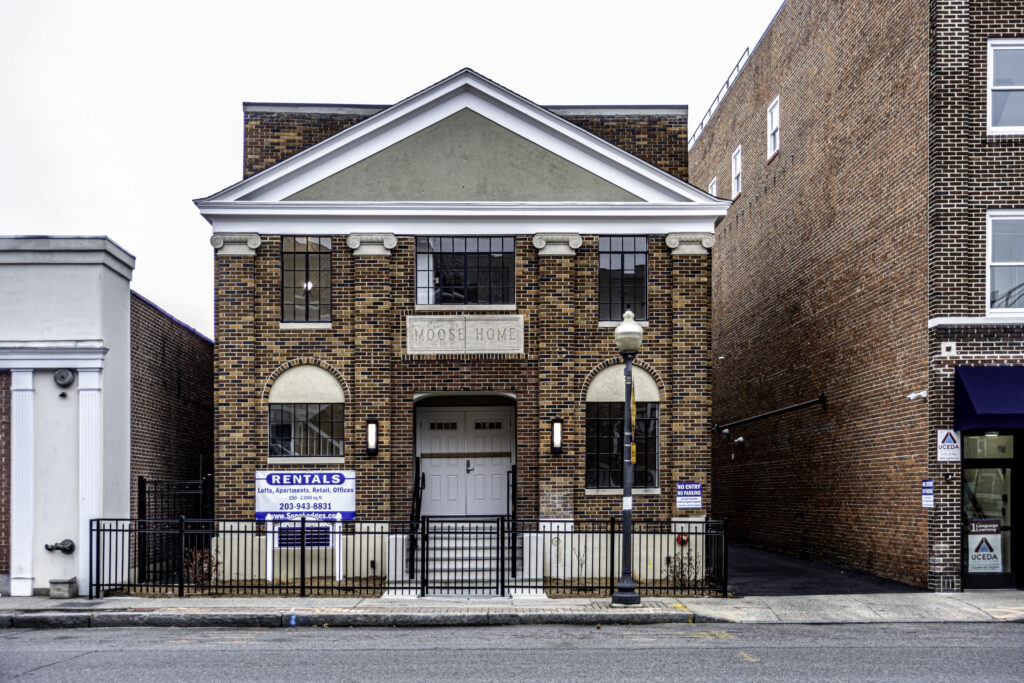
Photo Credit: Tod Bryant[/caption]
Aesthetic Importance of Older Buildings
Older buildings are often made with unique, valuable materials such as heart pine, marble, or old brick. They may have details and features you can’t find anymore, like decorative facades, unusual glasswork, or copper lining. Many people feel that older buildings have their own identity and distinctive character because of these features, making them more interesting than modern buildings. Retaining and maintaining old buildings means old methods of workmanship are also supported.
Environmental Considerations
The importance of recycling has become more and more understood on a household level, but preserving old buildings is recycling on a larger scale. Repairing and reusing existing buildings uses energy and material resources more efficiently and reduces waste. New materials don’t need to be created, nor are older demolished materials thrown away. Plus, energy for rebuilding is conserved. Also, tearing down structures may release toxins and pollutants into the environment.
Funding Opportunities
There are several programs available to help fund the rehabilitation of historic buildings. Municipalities and non-profit organizations can apply for
Historic Restoration Fund grants. Grants through
Preservation Connecticut are available to local governments, non-profits, and private homeowners. Non-profit housing corporations and homeowners may also be eligible for the state’s
Historic Homes Rehabilitation Tax Credit program.
Historic Preservation in Norwalk
Norwalk combines the character of a historic New England community on the coast of Long Island Sound with a thriving city in the county’s largest metropolitan area. One of the priorities outlined in Norwalk’s
10-year Citywide Plan is enhancing and preserving the city’s historic resources. Historic areas such as South Norwalk have seen investment and growth, while preserving its many historic structures and character.
The City’s
Planning & Zoning Commissions have recently enacted several regulations to encourage the preservation of historic structures. For example, if the historic structures are preserved, the Commission can reduce the amount of required parking, decrease building setbacks or increase building height or size for recognized historic structures. Two areas of the City where these regulations have taken effect are in South Norwalk (SSDD Regulations) and the Wall Street area (CBD Regulations).
In 2021, an 84-acre area around the South Norwalk train station in Norwalk, CT, traditionally known as
Springwood and Whistleville, was added to the
National Register of Historic Places.
Read More about Norwalk’s Zoning Regulations pertaining to Historic Preservation
Read More about Norwalk’s historic heritage on page 95 of the Citywide PlanNorwalk's Economic Outlook in 2022 and Beyond
 Throughout 2020 and 2021, the Connecticut Board of Labor reported high numbers of unemployment claims and other worrying statistics about the state's overall economic situation. However, a recent economic look at Norwalk, CT shows promise of growth and stability.
Throughout 2020 and 2021, the Connecticut Board of Labor reported high numbers of unemployment claims and other worrying statistics about the state's overall economic situation. However, a recent economic look at Norwalk, CT shows promise of growth and stability.
This Norwalk economic outlook was presented to the Norwalk Common Council earlier this year. Here's what Norwalk residents and business owners need to know about housing, new businesses, commercial real estate, and urban development in 2022.
Residential Housing
In January of 2022, the median listed home price in Norwalk, Connecticut was $550,000, a 10% increase from the previous year.
As of late February and early March of this year, the average single-family home sold for $750,000 and spent about 86 days on the market.
These price changes signal a robust residential housing market. According to the report, home vacancy rates are at an all-time low in Norwalk, CT. This could drive increased housing development in the form of single-family homes, apartments, and multi-family residences for people of every economic background.
New Businesses
To give an accurate assessment of new business growth in Norwalk, government officials focused their attention on two statistics.
First, they looked at the number of new business formations since July 2021. In that period, there have been 185 new businesses established. The committee projects that by June 2022, that number will reach 370.
Next, the city reviewed how many commercial tenant fit-up permits they've granted since the beginning of the fiscal year. There have already been 71, so they anticipate granting a total of 140 by the end of the fiscal year.
2020 only saw 101 commercial tenant fit-up permits granted to businesses while 2021 saw 131. With these promising statistics, it appears as if business development in Norwalk is seeing a rebound from the hardships of the Covid-19 pandemic.
Commercial Real Estate
To get a bigger picture of the Bridgeport-Stamford-Norwalk commercial real estate market, the commercial leasing activity in the area was compared to national averages. Overall, the state of commercial real estate appears to be weaker than national averages, especially in the retail property sector.
However, the following property sectors in Norwalk are stronger than the national averages:
- Apartments
- Offices
- Industrial
- Hotel/lodging
Insecurities about economic recovery in Norwalk were attributed to the rise of the Omicron variant earlier this year.
Class A office availability has increased to 38.3%. This increase in available office space is possibly due to changing attitudes about office workers working from home and sublease supply. The city continues to watch these trends closely.
Urban Development
Despite some weakness in the commercial real estate market, the City of Norwalk anticipates five new urban development projects that may see groundbreaking or applications in 2022:
- Pinnacle, 467 West Avenue—393 residential units and 26,000 square feet of commercial space in South Norwalk
- 10 Monroe Street—150 residential units and 16,000 square feet of commercial space
- A mixed-use commercial/apartment building at Monroe and Chestnut Streets near the South Norwalk train station
- A Wells Fargo site in East Norwalk
- Applications for commercial sites on Route 1
What This Economic Outlook Means for Norwalk's Future
In general, Norwalk city officials see this economic outlook report as promising. In both residential and commercial sectors, developers are laying building blocks for increased growth in the future. The City of Norwalk will continue to work with developers and seek input from residents and businesses.
Combined with reviews and updates to Norwalk’s
industrial zones,
industrial waterfront land uses,
zoning regulations and affordable housing plans, the City of Norwalk has high hopes for 2022's economic situation.
Stay tuned with the City of Norwalk. Give your ideas and feedback for the future plans for business development in Norwalk by
subscribing to updates, and make your voice heard.
Norwalk Residents Weigh In On Industrial Waterfront Uses
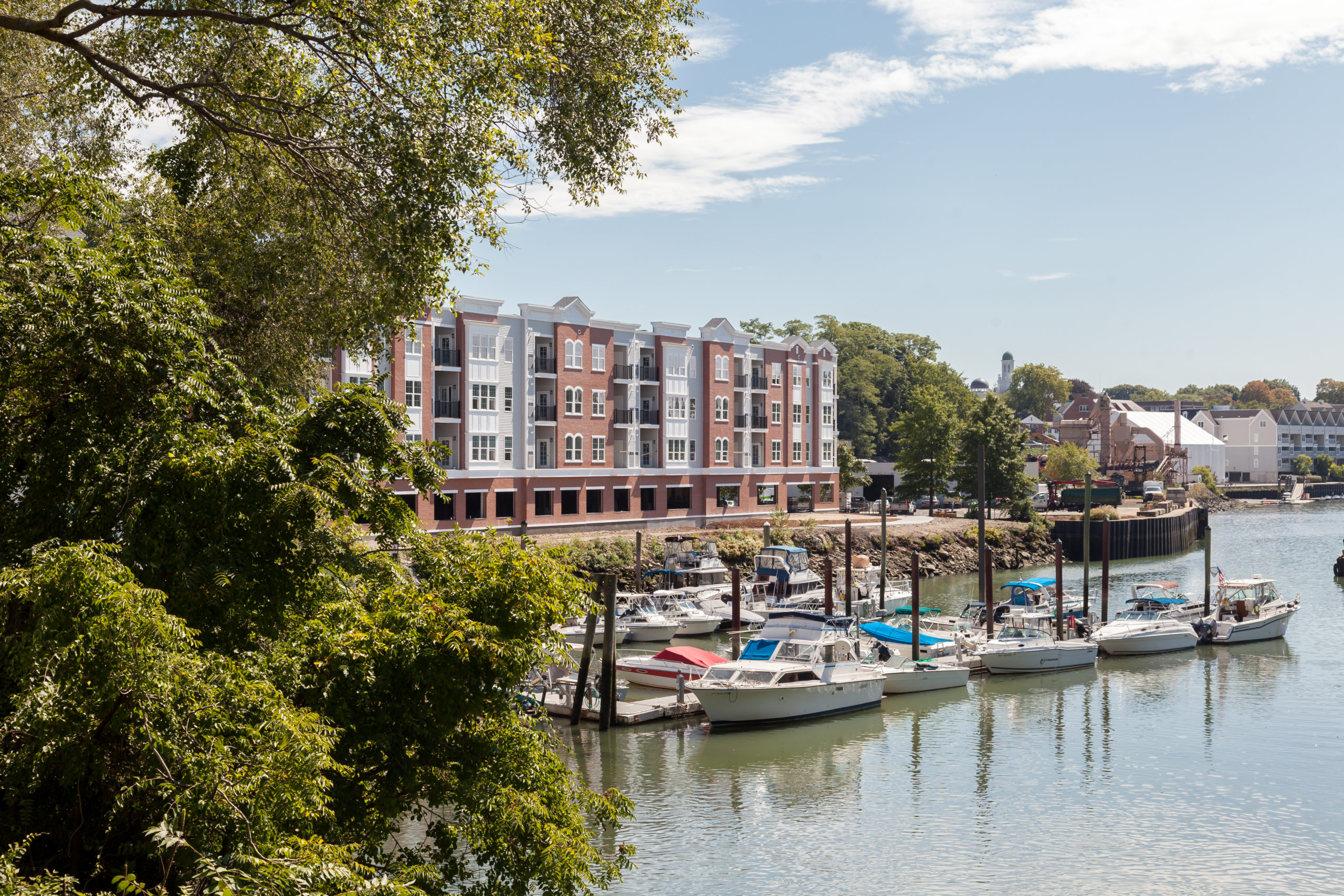 As the City of Norwalk studies how to optimize the industrial areas of its waterfront resources along the mid-to-upper Norwalk Harbor, the Planning and Zoning office is reaching out to the public and other stakeholders for their thoughts.
As the City of Norwalk studies how to optimize the industrial areas of its waterfront resources along the mid-to-upper Norwalk Harbor, the Planning and Zoning office is reaching out to the public and other stakeholders for their thoughts.
One of the ways planners have gathered input is via an online community mapping activity. This digital engagement, which started in late 2021, was the first of several opportunities to gather public comment. Participants added their input on how they would like to see the waterfront used via an interactive map where they placed comments pinpointing to specific areas in the study zone.
Keep reading to find out what the public would like to see along the industrial area of Norwalk’s waterfront.
Interactive Waterfront Survey Findings
In all, more than 150 comments were made by more than 55 stakeholders, with 1,100 people visiting the site.
A large majority of comments involved a desire to include public access and open space along Norwalk’s waterfront. Another popular comment was regarding infrastructure along waterfront areas such as the inclusion of sidewalks, paths and trails.
 Below are some of the most popular comments for various areas along the Norwalk River.
Below are some of the most popular comments for various areas along the Norwalk River.
Broader Marina District
The comments pinpointed to Veteran’s Park asked for improvements to the park and increased water access, the input being that the water frontage is substantially underutilized.
Some ideas included putting in better boardwalk/paved paths around the park, adding plantings, picnic tables and access for kayaks and canoes.
Along Water Street many respondents said they want to maintain the land for water-dependent uses, such as boatyards and aquaculture.
Many liked the suggestion that anything vacant in this area should be required to be landscaped into parks accessible to the public since this area is flood-prone.
East Bank of the Norwalk River
Input on the waterfront area on the River’s east side industrial-mixed use transition area included a desire by many to finish the Norwalk Harbor Loop Trail of which there is a missing section in this area.
Commenters also wanted to see cleanup of the old asphalt plant in East Norwalk, possibly turning the area into a park that could serve as a buffer zone to accommodate flooding that occurs in the area regularly.
Industrial/Commercial Business District Wall Street Area
Further up the river in the Wall Street area, many liked the idea of making the waterfront here more accessible to pedestrians, and increasing recreational marine uses such as canoe or kayak rentals.
Other comments included zoning the area for accessory uses that would enable cafes and restaurants. Respondents also expressed a desire to connect the area under the bridge leading to Freese Park with the Harbor Trail Loop.
Washington Street/Oyster Shell Park District
On the west side of the Norwalk River, a number of those surveyed would like to see the completion of pedestrian access from South Norwalk (SoNo) through Oyster Shell Park, making both pedestrian and bicycle access safer.
Others expressed an interest in a continuous boardwalk in SoNo on the waterfront from Washington Street to Elizabeth or Hanford Streets, including in front of the Maritime Aquarium.
Public Engagement for Industrial Waterfront Land Use Study
The Waterfront Land Use Study Steering Committee will continue to engage and inform the public with a series of public meetings.
Overall themes that came out of this original survey will be discussed and participants will be asked to rank the top three issues/concerns/themes that they would like this plan to address.
The committee will also make additional suggestions for land use and development intensity that the public can weigh in on.
Industrial Waterfront Land Use Study Public Engagement Meeting
WHAT DO YOU WANT FOR YOUR WATERFRONT?
Public Engagement Meeting #1
Join us on Zoom!
Please join us in our 1st public engagement meeting for an opportunity to share your opinions on land use scenario's for industrial and commercial properties along the upper to mid landward areas around the Norwalk Harbor! Norwalk 's Planning & Zoning Department has teamed up with Utile, an Architecture & Planning firm from Boston to help guide future land use around the Norwalk Harbor.
¿QUÉ QUIERES PARA TU WATERFRONT?
Reunión de participación pública #1
¡Únase a nosotros en Zoom!
¡Únase a nosotros en la primera reunión de participación pública para tener la oportunidad de compartir sus opiniones sobre escenarios de uso de la tierra para usos industriales y comerciales, a lo largo de las áreas superiores y medias de la tierra alrededor del puerto de Norwalk! El Departamento de Planificación y Zonificación de Norwalk se ha asociado con Utile, una firma de Arquitectura y Planificación de Boston, para ayudar a guiar el uso futuro de la tierra alrededor del puerto de Norwalk.
Examining the Use of Norwalk's Industrial Waterfront
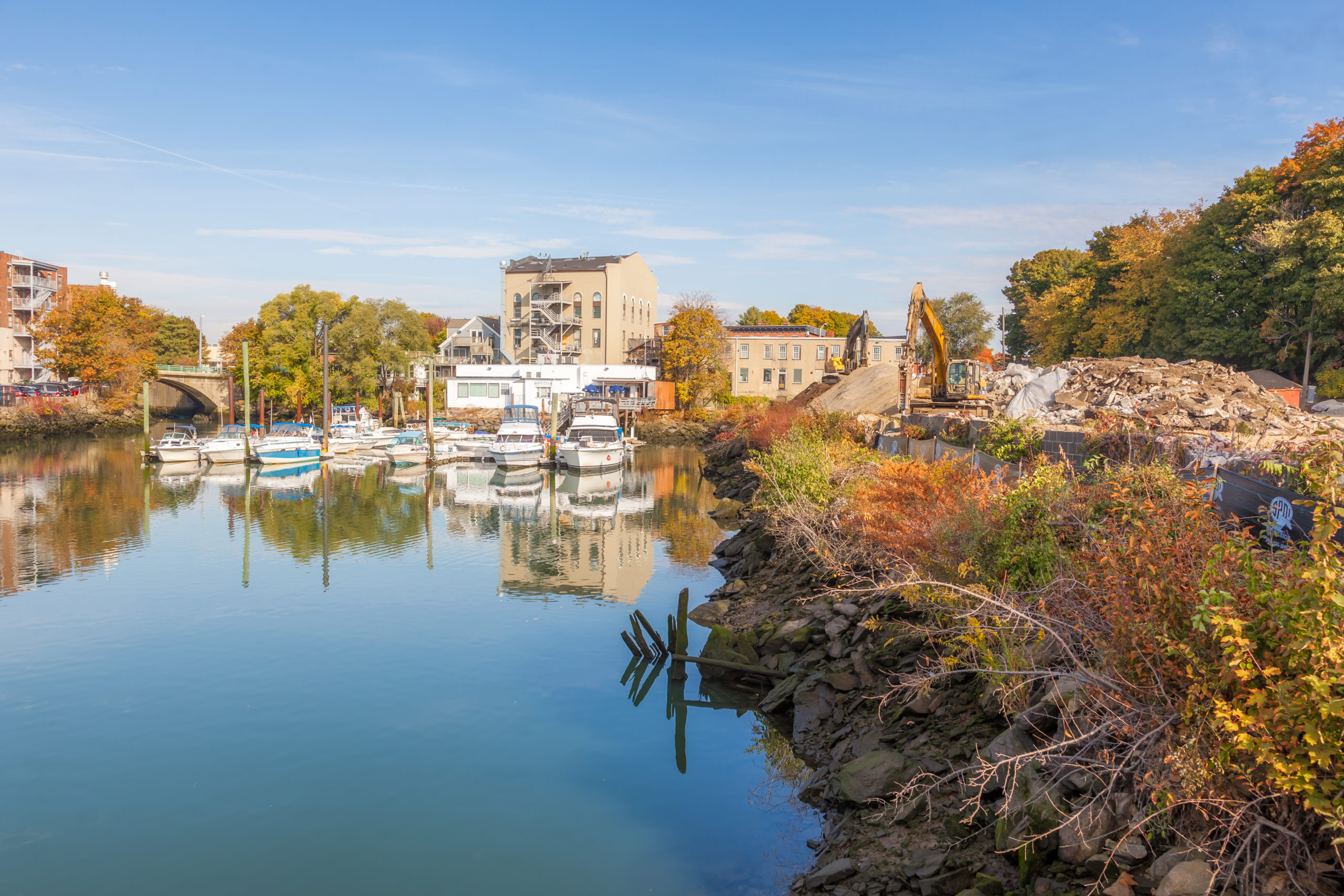 A beautiful city located on the Long Island Sound, Norwalk, CT has several photo worthy, waterfront destinations like the Maritime Aquarium or Calf Pasture Beach. These are great area attractions and unique spaces, but there are other waterfront areas, notably along the Norwalk River, that have historically been used for industry and other commercial purposes.
Norwalk is undergoing an assessment of the use of Norwalk’s industrial waterfront to determine what may be in store for the area. Read on to learn more.
A beautiful city located on the Long Island Sound, Norwalk, CT has several photo worthy, waterfront destinations like the Maritime Aquarium or Calf Pasture Beach. These are great area attractions and unique spaces, but there are other waterfront areas, notably along the Norwalk River, that have historically been used for industry and other commercial purposes.
Norwalk is undergoing an assessment of the use of Norwalk’s industrial waterfront to determine what may be in store for the area. Read on to learn more.
Economic Development and Norwalk's Waterfront
City leaders across the nation view commercial waterfront districts as an opportunity for sustainable development. Norwalk is one city undergoing such an evaluation.
The latest waterfront assessment is all about improving its waterfront properties to meet the needs of today. For example, Norwalk officials are reconsidering the use of the city’s industrial zones. At the same time, they’re examining how residents can best coexist with local industry.
City planners hope to answer these same questions along waterfront property with the latest industrial waterfront land use study. The study is the result of a recommendation from the initial Industrial Zones study which suggests that waterfront industrial uses should be assessed separately from inland industrial uses as a result of their unique qualities.
There’s an abundance of opportunities for Norwalk’s industrial property on the waterfront. The goal of the study is to ensure that the city meets the needs of residents and businesses. That’s why feedback from the public is being encouraged to influence how they move forward. The Industrial Waterfront Land Use Plan will be influenced by residents, business owners, and other local constituents.
Examining Industrial Waterfront Uses
Part of the process of rethinking the Norwalk waterfront is to examine how the land zoned for industry is currently used. Already, there are several well-established businesses along the Norwalk River. They range from commercial marine facilities, to recreation and tourist areas, to industrial and commercial business districts. Many of these uses add to the maritime character of Norwalk and play a role in the regional and State economy.
Environmental Considerations for Norwalk's Waterfront
In addition to creating more jobs and offering recreational and other options, officials also want to protect the area’s natural resources. The waterfront study will evaluate several environmental concerns, including:
- Flood hazards
- Dredging for navigation channels
- Water quality
The study will identify areas of high risk or high environmental sensitivity such as low lying areas that may be prone to flooding or areas receiving polluted run-off from their land side counterparts. It will also look at areas in the river that may be in need of dredging and determine any environmental considerations.
The final plan will incorporate best practices for zoning standards to minimize stormwater runoff and support water quality by adding things like permeable pavement and landscape buffers.
Planning for Norwalk's Future Waterfront
The ultimate goal of Norwalk’s Industrial Waterfront Land Use Study will be to determine how to best make use of waterfront property in the future. It also will consider opportunities for public access and recreation. Overall, the city’s new plans for the Norwalk River will prioritize water-dependent uses. Water dependent uses are valued by local citizens because of the role they play in creating a sense of place in Norwalk. They are also prioritized by the State Department of Energy and Environmental Protection.
This plan will help city officials assess the aspirations, ideas, and needs of residents and businesses with regard to the local waterfront. The outcome of this study will be a new framework for regulations and rezoning in the area. More importantly, it will highlight projects that will result in a healthy, vibrant, and dynamic waterfront for Norwalk.
Help Shape the Future of Norwalk's Waterfront
The City of Norwalk would love to hear your ideas and feedback for the future plans for Norwalk’s industrial waterfront. Please feel free to visit our Norwalk Tomorrow feedback map and make your voice heard.






 Photo courtesy of Nancy Chapman[/caption]
Photo courtesy of Nancy Chapman[/caption]

 A significant portion of the waterfront in Norwalk, CT has been zoned and used for industrial use. The city undertook a planning exercise to determine the appropriate land uses for these historically industrial waterfronts. The draft plan, Industrial Waterfront Land Use Plan, has been developed for the city to use as a policy roadmap, allowing these areas to grow and change in a way that balances and aligns with both public and private needs.
A significant portion of the waterfront in Norwalk, CT has been zoned and used for industrial use. The city undertook a planning exercise to determine the appropriate land uses for these historically industrial waterfronts. The draft plan, Industrial Waterfront Land Use Plan, has been developed for the city to use as a policy roadmap, allowing these areas to grow and change in a way that balances and aligns with both public and private needs.  Historic buildings are more than just old structures—they are vital threads in the fabric of a city’s identity. Preserving them not only honors the past but also shapes the character and future of a community. From economic benefits to environmental sustainability, the case for preserving historic architecture is compelling. Let’s explore why safeguarding these treasures is crucial and how Norwalk is leading the way.
Historic buildings are more than just old structures—they are vital threads in the fabric of a city’s identity. Preserving them not only honors the past but also shapes the character and future of a community. From economic benefits to environmental sustainability, the case for preserving historic architecture is compelling. Let’s explore why safeguarding these treasures is crucial and how Norwalk is leading the way.
 Photo Credit: Tod Bryant[/caption]
Photo Credit: Tod Bryant[/caption]
 Throughout 2020 and 2021, the Connecticut Board of Labor reported
Throughout 2020 and 2021, the Connecticut Board of Labor reported  As the City of Norwalk studies how to optimize the industrial areas of its waterfront resources along the mid-to-upper Norwalk Harbor, the Planning and Zoning office is reaching out to the public and other stakeholders for their thoughts.
As the City of Norwalk studies how to optimize the industrial areas of its waterfront resources along the mid-to-upper Norwalk Harbor, the Planning and Zoning office is reaching out to the public and other stakeholders for their thoughts. 
 A beautiful city located on the Long Island Sound, Norwalk, CT has several photo worthy, waterfront destinations like the Maritime Aquarium or Calf Pasture Beach. These are great area attractions and unique spaces, but there are other waterfront areas, notably along the Norwalk River, that have historically been used for industry and other commercial purposes.
A beautiful city located on the Long Island Sound, Norwalk, CT has several photo worthy, waterfront destinations like the Maritime Aquarium or Calf Pasture Beach. These are great area attractions and unique spaces, but there are other waterfront areas, notably along the Norwalk River, that have historically been used for industry and other commercial purposes.

